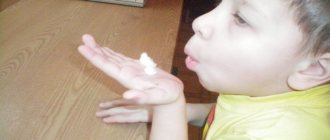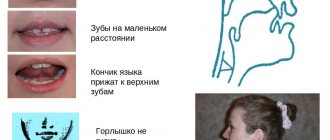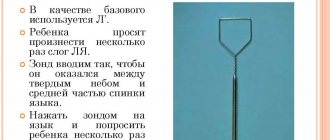Failure to pronounce the sound [L'] is the most common defect in children's speech. The kid can replace the inconvenient letter with another consonant or sound, saying instead of “puddle” - “vuzha”, “swim” - “puavayu”, or ignore it altogether: “lion” - “ev”, “fox” - “isa”.
Until the age of five, the absence of a number of letters in an infant's vocabulary is not a big problem. However, the speech impediment must be corrected quickly, without prolonging the situation.
How to teach a child to say the letter L so that his speech is correct for school?
Why does a child pronounce a sound incorrectly?
The sound [L'] is considered complex and is the last to be mastered by the baby.
If by the age of 5 speech disorders persist, then perhaps the reason lies in the following situations:
- someone close to you pronounces “L” incorrectly, and the baby imitates him;
- poor phonemic awareness. A 3-5 year old child can already distinguish all types of consonants by ear: hissing, voiceless, voiced, etc. Even when he cannot pronounce them correctly, he must correctly indicate the mouse or bear in the picture. If the baby has undeveloped phonemic hearing, in the future there will certainly be difficulties with writing and reading. You need to be able to distinguish all sounds by the age of 4;
- the family speaks 2 languages. This is always a risk for the development of speech disorders. In this situation, it is considered normal if both languages are acquired with a slight delay;
- short frenulum of the tongue. Normally, for 5-6 year old children, its length should be 8 cm. If shortening or thickening of the frenulum is detected, then there will definitely be difficulties with the pronunciation of “L”. The problem can be solved either surgically or conservatively with the help of articulatory gymnastics.
A consultation with a speech therapist or dentist will help you find out the cause of incorrect pronunciation.
Experts note that only 10% of children aged 4-5 years can clearly pronounce the sound [L'].
Reasons for incorrect pronunciation of sounds
Speech therapists focus parental attention on the fact that the problem is considered to exist only if a child after 5 years cannot pronounce “r” and “l” correctly. Otherwise, this is just a variant of the norm.
The sounds “r” and “l” are considered complex, and they are the last to be mastered. For full pronunciation, several components are necessary: sufficient development of the speech apparatus, the child’s ability to retain the spoken sound. If a child’s pronunciation has not improved after 5 years, there may be several reasons for this.
Tongue frenulum
The frenulum of the tongue is attached to the floor of the mouth and its other end is woven into the tongue approximately in its middle. In clinical practice, you can find its shortening when it is woven into the upper third of the tongue, significantly limiting its movements.
note
A short frenulum of the tongue can be diagnosed in the maternity ward, where its correction is carried out, since breastfeeding and even bottle feeding is impossible.
But most often, a short frenulum is detected much later, when problems with speech appear. By the age of 5-6 years, the child’s tongue frenulum should be approximately 8 mm , this is the length that ensures normal movements of the tongue. If it is diagnosed as shortening, thickening, or restriction of movement, then children are almost 100% likely to develop problems in the pronunciation of “r” and “l.”
Correction of the frenulum can be done either by a dentist - a surgical method, or by a speech therapist - conservatively. The solution to this issue is a stumbling block between the two specialties.
Impaired sound pronunciation
Incorrect pronunciation of the sounds “r” and “l” may be associated with incorrect pronunciation of other sounds mastered earlier. Most often, children develop confusion in the pronunciation of whistling and hissing sounds, which results in problems with the pronunciation of “r” and “l”.
Often such violations become the reason that the child confuses them in everyday speech (“Kla, calls volona, klazha, kalaul”). According to speech therapists, such disorders are the easiest to correct. The fact is that “r” and “l” are similar in pronunciation methods: the tongue is in approximately the same position, but “l” is easier to pronounce, so children take the easiest path. If “p” is replaced with other sounds, then the situation is somewhat more complicated and experts suspect phonetic hearing impairment. If children “swallow” this sound, then phonetic perception is most likely impaired.
Phonetic hearing disorders
Selective perception of individual sounds, when a child hears “sh”, “ch”, “k”, “a”, but does not hear “r”, and automatically replaces it with “l” and is called phonetic hearing disorder.
Phonetic hearing reaches the peak of its development by 4-5 years, but parents can notice its impairments even before this age. The earlier the problem was diagnosed and measures taken to correct it, the greater the chances of success.
note
The formation of active and passive vocabulary, the development of phonetic hearing occurs precisely during oral speech. Therefore, experts do not recommend cooing with children; parents’ speech should be correct and clear, which will help children avoid many problems with oral speech.
If parents notice “symptoms” of a phonetic sound disorder, they need to show the child to a specialist as soon as possible. Such disorders may indicate certain diseases of the central nervous system, adenoid vegetations or otitis media, which have a hidden course.
Speech apparatus
The speech apparatus is the tongue, cheeks and lips. Omissions in the pronunciation of some sounds may indicate their insufficient development and those muscles that are involved in the formation of speech; the reason may also be hidden in hypo- or hypertonicity, which equally affects sound pronunciation.
Behavior problems
Mastering the sounds “r” and “l” requires concentration and some effort from the baby. It has been noticed that problems with sound reproduction are more often recorded in children with special behavioral reactions, for example, with attention deficit hyperactivity disorder, but there is also the other side of the coin - children prone to apathy.
Throat sounds
Even if speech development proceeds according to norms and average statistical indicators when mastering the sounds “r” and “l,” children can follow the “lazy” path. This path of least resistance refers to the reproduction of guttural sound when vibrations are generated by the uvula of the larynx.
This speech therapy problem is quite difficult to correct, because it requires retraining the child. Complicating the situation is the fact that many parents cannot distinguish a correctly pronounced sound from a guttural one, and the longer the problem exists, the more difficult it is to relearn.
How to properly organize classes at home?
If the speech therapist does not find any problems with the baby’s articulatory apparatus, you can try introducing the sound [L'] at home. For correction exercises to be effective, parents must remember that the best way for a child to learn is through play.
Here are a few simple rules that, if followed, will make lessons fun and effective:
- talk to the child on an equal footing and respectfully, answer all his questions. This will raise his self-esteem and stimulate him to further learning;
- pronounce each word or syllable clearly and distinctly. The parent is a role model, and the baby will try to repeat the sounds correctly;
- conduct classes in the form of fairy tales, performing a small performance. This captivates the child, and he assimilates any information better and easier;
- do not delay training. If you feel that your baby is tired, you should stop lessons. It is not recommended to conduct classes as punishment - as an educational measure, this will not bring any results;
- Regular exercise is very important. They should be carried out 3-5 times a day. For lessons, it is better to choose a time that is comfortable for the child, so you can achieve tangible success.
It is necessary to appreciate the child’s personality and not mock him. Praise for every success, even the most insignificant, and he will quickly learn to correctly pronounce the naughty letter “L” without outside help.
What is lambdacism and paralambdacism?
Incorrect pronunciation of the sound “l”, “l” or its complete absence has a scientific name - lambdacism. It is divided into 4 types:
- nasal. The sound coming out with the air flow tends to enter not through the mouth, but through the nose. This occurs when the root of the tongue pushes against the roof of the mouth, obstructing the passage. In such cases, instead of “l”, it turns out “ng lapa-ngapa, lak-ngak;
- bilabial. The child puts his lips in a tube, so that instead of the prescribed “l”, the result is “u”: doctor-whecker, lamp-uampa;
- interdental. The tip of the tongue gets into the space between the teeth, producing an incorrect sound;
- lack of "l". One of the most common options. The baby does not pronounce “l” at all; instead, words without it are obtained: Luk-uk, lens-inza.
What lambdacism is is now clear, but what then is paralambdacism. This includes replacing “l” with other sounds. Such replacements include:
- replacing “l” with the sound “v” or “b”: lala - woman, lava-vava, moon-wuna;
- replacing “l” with “g”: gog-gog, table-stack;
- replacing “l” with “d”: horse-horse, lupa-dupa;
- replacing “l” with “ya”, “yo”, “yu”: lader-yager, spoon-hedgehog, bow-yuk;
- replacing “l” with a soft “l”: doing-sharing.
Correct articulation
Articulation gymnastics will help correct incorrect pronunciation of sounds. It is necessary to train the tongue, stretch the frenulum, and stretch the baby’s lips and cheeks. All this will prepare his speech apparatus for clear and firm pronunciation of words.
Basics of correct articulation:
- lips stretched in a smile, teeth slightly covered. The tip of the tongue rests on the upper central incisors or gum;
- mastering speech breathing: the child makes a sound, a strong stream of air goes around the tongue and comes out of the mouth. This is an important point. Speech occurs while exhaling, so improper air distribution greatly distorts pronunciation. Playing with soap bubbles helps develop breathing. It is important that the baby takes air into the lungs, and not into the cheeks;
- vocal cords are closed. Place your palm against your throat: when pronouncing the sound [L'], vibration will be felt.
Children are big fans of making faces, you can use this when teaching your child how to pronounce the letter “L” correctly:
- smile . Ask the baby to smile widely without opening his lips. You need to hold out for 8-10 seconds. Repeat the exercise 6-7 times a day;
- horse _ The baby tries to imitate the clatter of hooves. Let the child smile with his mouth slightly open, and in this position click his tongue, first slowly, then faster and faster. Only the tongue should work, the lower jaw does not move;
- painter _ The tongue strokes the palate, as if painting it. Movements: from the teeth and deep into the mouth;
- swing . Alternately push the upper and lower teeth with the tip of your tongue, gradually increasing the pace. You need to do 6-8 repetitions. The purpose of the exercise is to learn how to quickly change the position of the tongue. This skill is useful for mastering syllables where the letter “L” is combined with vowels: “la”, “lo”, “il”, “ul”, etc.;
- jam . The mouth is slightly open. The baby licks his upper lip with his tongue: up and down. The lower jaw should not move. If the exercise does not work, then first you need to teach the baby to keep a relaxed, protruding tongue on his lower lip. You can offer to compete with the baby to see who can hold this position longer. Then the tongue can be raised, touching it to the upper lip;
- tube _ Roll your tongue into a tube as tightly as possible;
- brushing teeth . Move your tongue along the inside of the upper row of teeth: from right to left and back;
- breeze _ The mouth is slightly open in a smile. The child bites his tongue and blows out air. 2 jets should form. To check the correctness of the exercise, you can bring a feather or ribbon to your mouth, this will stimulate and diversify the child’s activity;
- steamship whistle . The baby opens his mouth and pronounces the sound [Y'] for a long time. In this case, the tip of the tongue is lowered and located in the depths of the mouth, and its back is raised to the palate;
- fungus _ It is performed by pressing the tongue firmly against the palate.
All exercises are carried out together in front of a mirror: the baby must see the parents’ movements and repeat them. The purpose of the classes is to develop tongue mobility and correctly regulate the air flow as you exhale.
Several ways to make the sound L
First way. Open your mouth wide. Make sure your upper and lower teeth are visible. Then stick your wide tongue out between your teeth, pronounce the sound A and immediately press it with your teeth. As a result, you will get a combination of the sounds A and L. As soon as you are able to pronounce the sound L in this position, move your tongue to the correct position - it should be raised up and rest against the gums or teeth.
Second way. Say the sound Y. Then say simple words that contain the syllable LY, for example, lyko, skis, and so on. When you are able to pronounce the sound L in the interdental position, move the tip of your tongue to the correct position.
Step-by-step instructions on how to teach your child to pronounce the letter correctly
Before seeking the help of a speech therapist, you can try to teach your child the correct pronunciation on your own:
- first step: show the baby how to pronounce the letter “L” correctly: the tongue is pressed to the upper teeth, the lips are smiling, the teeth are slightly visible. If the desired pronunciation is not achieved, you can teach the child to pronounce the sound [ы'] abruptly and clearly. When this stage is mastered, move on;
- step two . The soft sound [L'] comes easily if its hard pronunciation is mastered. How to teach a child to pronounce a hard “L” - pinch (bite) the tip of the tongue with your teeth and ask him to say “Y”;
- third step. After the correct sound has been heard, the baby moves the tip of his tongue back to the upper teeth and practices clear pronunciation;
- step four . Vowel sounds are added to the letter “L”: “la”, “lu”, “ly”, “lo”, etc. After successfully mastering the direct combination, they move on to the skills of reverse pronunciation of sounds - “al”, “ul”, “yl” ", "ol";
- step five . Fixing the material. When the baby has mastered the sound of syllables and words, you can choose poems where the letter “L” appears often.
Dr. E. Komarovsky recommends singing with your child. Harmonious sounds will not only teach the baby to change rhythm and tonality, but will also develop the speech apparatus. Modeling, drawing with thin pencils, cutting out appliques, finger games, all this contributes to the baby’s intellectual development and stimulates nerve endings, improving the development of speech skills.
At first, you need to ensure that the baby uses the sound [L'] in his vocabulary more often, until the habit develops into a skill.
When is drastic intervention necessary?
Speech therapy exercises may well conservatively correct the length of the frenulum of the tongue, but this process is long and complex, and the results do not always live up to expectations.
To act conservatively or surgically has been and still remains one of the controversial topics between dentists and speech therapists. Each group of specialists provides arguments in its favor.
Meanwhile, there are strict indications for surgical correction:
- If the frenulum is woven into the upper third of the tongue and interferes with proper feeding or significantly limits the movements of the tongue;
- The appearance of severe pain during speech therapy exercises;
- Injuries;
- And etc.
In any case, if the reason for the incorrect pronunciation of the sounds “r” and “l” lies precisely in the shortening of the frenulum, a consultation with a dentist and a joint decision on further treatment tactics is necessary.
Modern dentistry has painless methods for frenulum correction with a minimal rehabilitation period. We are mainly talking about the use of a laser, which allows you to reduce the recovery period to several hours and avoid many possible complications.
The frenulum itself does not have nerve endings, therefore, its correction is painless, but anesthesia is required to ensure the comfort of the small patient, reduce the gag reflex, etc.
After the operation, dentists recommend carefully maintaining oral hygiene: rinsing the mouth with antiseptic solutions to prevent infection.
You can return to speech therapy classes after surgery within a week. If sutures are needed, 5-6 days after their removal.
At the end of the rehabilitation period, children begin to pronounce the sounds “r” and “l” much more clearly, but this does not mean that classes with a speech therapist are not needed. There is still a lot of work ahead to develop correct pronunciation and consolidate the results.
Teaching a child the correct pronunciation of the sounds “r” and “l” is a long process that will require effort and time from both the parents and the child. A positive outcome will depend only on a focus on results, working in tandem and conscientious implementation of all the specialist’s recommendations. Parents must understand that even after the baby has learned to pronounce sounds correctly, without proper training, it will not stick. But you shouldn’t put pressure on the child - this is a gradual process, the sound has already appeared, and sooner or later it will be possible to consolidate it.
Alena Paretskaya, pediatrician, medical columnist
14, total, today
( 108 votes, average: 4.58 out of 5)
11th week of pregnancy: how mother and baby feel
Staphylococcus during pregnancy: causes, treatment, prevention
Related Posts
When is the help of a speech therapist needed?
Sometimes home exercises to correct sounds do not produce results, the reasons may be the following:
- Russian is not the family’s native language, so adults speak with an accent;
- the baby was unable to master correct pronunciation after long exercises;
- someone from the adult environment has a diction defect and cannot conduct classes.
Since you couldn’t fix the problem yourself, you should seek the help of a specialist. Producing sounds is a special skill that only comes with experience.
The speech therapist will examine and listen to the little patient and offer to attend individual classes or group training. The task of parents is to be able to captivate the child by stimulating him to attend trainings. Even if the baby is not yet successful, he still needs to be praised and supported emotionally.
The feasibility of speech therapy classes
Some parents do not think about how to teach their child to say the letter L. They do not consider the defect to be something serious, but in adult life it will become the basis of complexes and worries.
Important! It is better to correct speech disorders in preschool age, then the process will take a little time.
Programs for speech development in preschool educational institutions in accordance with the Federal State Educational Standard
If parents do not know how to correctly teach their child to pronounce the letters L and R, then they should contact a specialist. A speech therapist will be able to correct this problem and develop the desired pronunciation.
How many lessons does it take to produce sound [l]
It is impossible to say with certainty how many lessons will be required to eliminate the defect. Sometimes sound production takes one session, in other situations it will take more than 30-40 meetings.
It all depends on the characteristics of the child, his motivation and the interest of the parents. Learning to pronounce the sound [l] is not so easy, since a preschooler gets used to a certain stereotype. Due to their age, it is still difficult for children to perceive learning activities.
How does an individual sound production lesson work [l]
The speech therapist performs sound production only after the student performs articulatory gymnastics well. The complex is performed strictly in front of a mirror. Afterwards they do breathing exercises and perform speech hearing tasks.
How does an individual lesson on sound automation work [l]
The speech therapist conducts individual lessons on automating the sound [l] only after calling an isolated pronunciation. At such lessons, the specialist develops the lexical and grammatical structure of speech, phonetic and phonemic hearing.
To do this, use different games and simulators. Modern speech therapists use computer games. Parents are required to participate in the process and carry out the specialist’s tasks at home.
Important! The duration of the lesson for preschool age is approximately 25 minutes. Physical minutes are required to switch activities.










